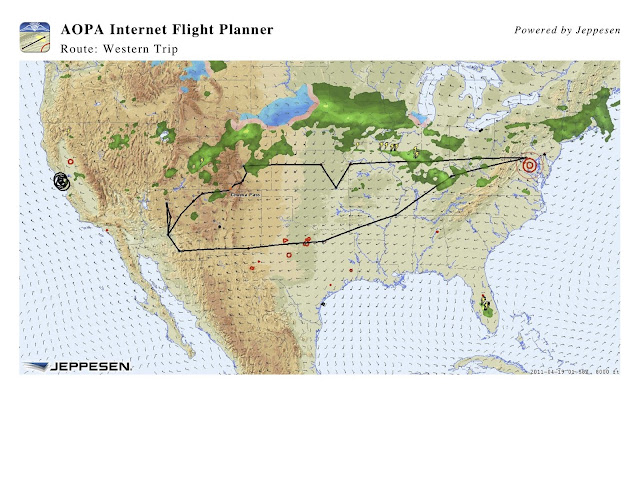Look at that sky. Morning at the airport shared by Cessna's Independence KS factory (in the left background). We got the bag drag out of the way early and headed for the main entrance. Aleen Swart was kind enough to haul us around the factory, and bravely brought only a cattle prod and a whip to keep us in line.
Pictures are not allowed inside the facilities during our visit, but Aleen gave us a great overview of their production. The factory assembles virtually all their piston driven aircraft (the new C-162 Sky Catcher, the C-400 Corvallis, C-172s, C-182s, C-206s, and C208s - I think that's all we saw today) plus the Mustang very light jet. Very impressive production facilities.
As you might expect, production has fallen off with the economy, though they apparently see some opportunities. The high end of the Mustang line, which appeals to buyers interested in high end appointments, found a few. There is a steady level of activity among all the aircraft lines. Cessna, like others, shops around for deals to hold down costs. There are examples everywhere. Apple has a lot of foreign made components and several years ago went through some growing pains. It seems Cessna has some of the same teething problems.
One of my "lust for" aircraft" (defined as one of a very few whose prices I whimsically follow in Trade A Plane) is the Corvallis 400. It is Cessna's first all composite aircraft. For those who do not know its history, it was originally a kit plane constructed by Lancair in Bend, Oregon. As time passed a Columbia factory version was produced and I think that part of the business was spun off. In the last decade, the Columbia 400 got into a "fastest production single piston engine prop" race with Mooney and Cirrus. My last recollection is it still holds this record, but you should verify.
Cessna bought Columbia a few years ago. Although there was talk of keeping production in Bend, the economy seems to have settled the issue and production moved to Independence. Now, composites have some unique production requirements. One cannot simply pull out the Elmer's glue and have at it in any conditions. Aleen says about 50 Bend people made the move to the plains with their families and their knowledge of production, but many missed the mountains and returned home. Like many other companies trying to remain competitive, Cessna restructured to take advantage of global capabilities, moving some Columbia, now renamed "Corvallis", component production to facilities at Tam, Mexico.
Well, factories were certified by the FAA, production began, and lo and behold, delamination became a problem. This is not the first time delamination issues have arisen. I recall the Air Force had delamination in some fighter aircraft a while back, so running into such a problem is neither unheard of nor a major sin in the world of high tech construction techniques where everyone is still learning. You just need deep enough pockets to last long enough to take advantage of the experience. In Cessna's case, it was costly. The FAA had to recertify the Tam facility, and there were delays in Independence production.
To their credit, there is also a lot of learning and relearning going on in Cessna. There were what appeared to be four complete Corvallis fuselage and wing sets on the floor in Independence. They were being used to take core samples to understand what had happened and how to avoid it in the future. In the end, these components will either become aircraft on sticks or ground up and disposed of, having served a purpose very different from the design intent. In the end its pretty sad to see all that effort come to this conclusion.
Its interesting to speculate why some of these things happened. It seems clear that judgements concerning the constant balancing act between people, technology and finance got a little skewed somewhere along this path. You can't claim the production move to Tam was a bad decision economically or technically. Apple does just fine with the quality of its products and gets good marks for reliability. One might be able to claim the learning curve establishes limits to the movement of high tech production techniques even where the technology is well known and understood. Where it is still evolving, that speed sign might be a little blurry, and a sudden burst of economic motivation might push you past the limit. That could plausibly have happened here. Maybe someday someone will publish the insider story of why Jack Pelton made such a sudden career change. Maybe the Corvallis story has a part. Maybe its only a small part, or completely unrelated. Interesting.
All in all, we thoroughly enjoyed the tour. Ann made it clear from outset that I couldn't have one (actually, all she said was "no", but I read many other things into it). I may not get an opportunity to drool over so many new aircraft in the near future so one must take advantage of one's opportunities. Aleen offered a bib, but I declined - the guys on the floor did not seem to mind ;-).
After thanking Aleen for all her help, in a matter of minutes we departed the factory, got back to the FBO, fired up 21T, and launched visual flight rules (VFR) for Abilene KS and an evening with our friends Dave and Karen Jerabek. Look at that sky.
More on Abilene tomorrow.
























 I
I
























